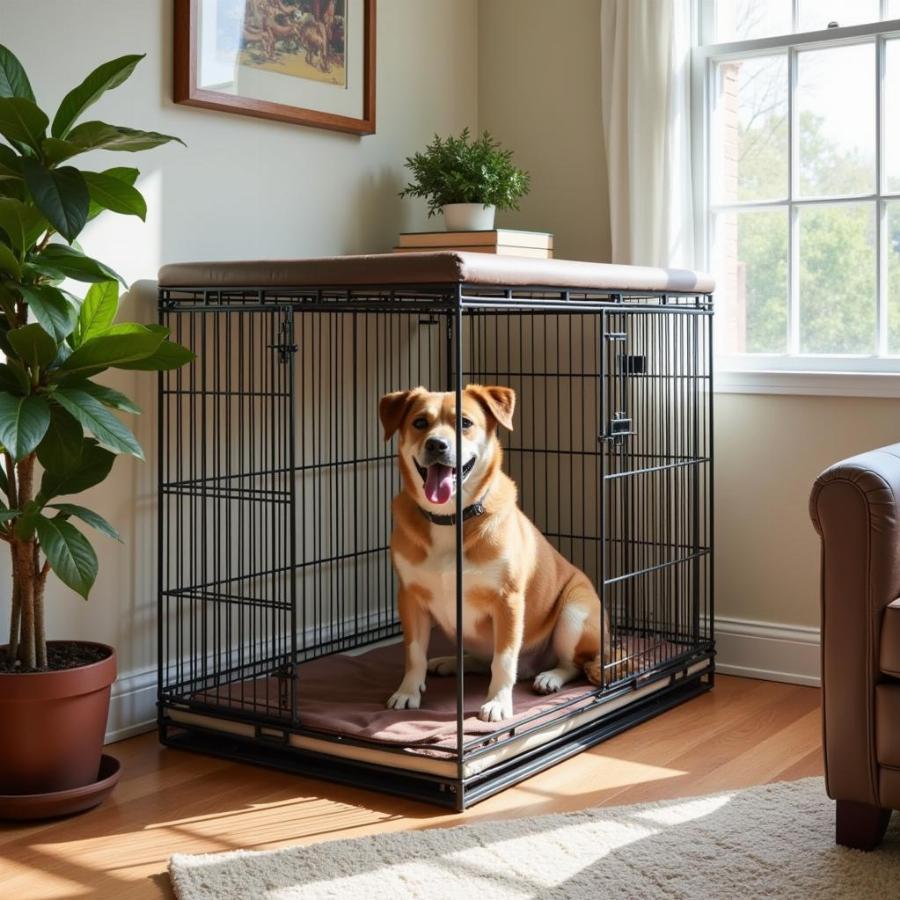Finding the perfect indoor kennel for your large breed dog can feel like a daunting task. You want a space that’s both comfortable for your furry friend and practical for your home. Whether you’re looking for a temporary safe space for training or a more permanent den-like retreat, choosing the right big dog kennels indoor is a crucial decision for responsible pet owners. This guide will cover everything you need to know, from sizing and material considerations to placement and enriching the kennel environment.
Choosing the Right Size for Big Dog Kennels Indoor
Size is paramount when selecting an indoor kennel for your large dog. A kennel that’s too small will restrict movement and cause discomfort, potentially leading to anxiety or behavioral issues. Conversely, an excessively large kennel can make your dog feel insecure. Measure your dog from nose to tail and from paw to the top of their head while standing. Add a few inches to both measurements to ensure ample room for your dog to stand, turn around, and lie down comfortably. Remember breeds like Great Danes, Mastiffs, and Saint Bernards require significantly more space than smaller large breeds such as German Shepherds or Labrador Retrievers. Consider your dog’s adult size if you’re buying a kennel for a puppy.
Material Matters: Durability and Cleanliness
The material of your indoor kennel significantly impacts its durability, cleanliness, and your dog’s comfort. Heavy-duty plastic kennels are popular for their durability, ease of cleaning, and affordability. Metal kennels offer superior strength and ventilation but can be colder in winter months. Wood kennels are aesthetically pleasing and provide good insulation but require more maintenance. Consider your dog’s chewing habits; a determined chewer might require a more robust material like metal.
Placement is Key: Creating a Welcoming Den
Where you place your dog’s indoor kennel is just as important as the kennel itself. Avoid placing it in areas with high foot traffic, loud noises, or extreme temperatures. Choose a quiet corner of your home where your dog can feel safe and secure. Proximity to family areas can help your dog feel included, while allowing them to retreat to their kennel when they need a break.
 Placing an Indoor Kennel in a Quiet Corner
Placing an Indoor Kennel in a Quiet Corner
Enriching the Kennel Environment: Comfort and Entertainment
A comfortable and stimulating environment within the kennel is essential for your dog’s well-being. A soft, washable bed provides cushioning and warmth. Adding familiar toys and blankets can create a more comforting and den-like atmosphere. Consider providing chew toys to keep your dog occupied and prevent boredom. Rotate toys regularly to maintain novelty and prevent your dog from becoming disinterested.
What are some good options for Great Dane dog kennels?
For Great Danes, you’ll need extra-large indoor kennels. Look for metal or heavy-duty plastic options that offer ample space for these gentle giants. Ensure the kennel is tall enough for them to stand comfortably. A great dane dog kennel should be durable and well-ventilated.
How do I introduce my dog to their new indoor kennel?
Introduce your dog to their new indoor kennel gradually and positively. Start by placing treats and toys inside to encourage exploration. Never force your dog into the kennel. Make it a positive experience with praise and rewards. You can even feed your dog their meals inside the kennel to create a positive association.
Are there specific indoor kennels recommended for senior dogs?
Senior dogs often benefit from indoor kennels that offer added comfort and support. Look for kennels with lower entrances for easy access and orthopedic bedding for joint support. A dog kennel large indoor with a raised bed can also be beneficial.
Conclusion
Choosing the right big dog kennels indoor is a significant investment in your dog’s comfort and well-being. By considering factors like size, material, placement, and enrichment, you can create a safe and comfortable haven for your beloved companion. Remember, a well-chosen indoor kennel can be a valuable tool for training, providing a secure space, and promoting relaxation for your large breed dog. Finding the perfect fit will ensure both you and your furry friend enjoy the benefits of a well-designed indoor kennel.
FAQ
- What size indoor kennel is suitable for a Mastiff?: Mastiffs require extra-large kennels. Measure your dog to ensure adequate space for standing, turning, and lying down.
- Can I use an indoor kennel for house training?: While not the primary method, indoor kennels can be helpful for house training by providing a designated space.
- How do I clean a plastic dog kennel?: Plastic kennels can be easily cleaned with soap and water. Ensure the kennel is completely dry before allowing your dog back inside.
- Are wire kennels good for large dogs?: Wire kennels offer excellent ventilation but may not be suitable for strong chewers or dogs prone to anxiety.
- What type of bedding is best for indoor kennels?: Soft, washable bedding is ideal for indoor kennels. Orthopedic beds are recommended for senior dogs.
- Can I leave my dog in an indoor kennel all day?: No, dogs should not be left in kennels for extended periods. Kennels are meant to be a safe space, not a place of confinement.
- How do I prevent my dog from barking in their kennel?: Ensure the kennel is comfortable and enriching. Address any underlying anxiety or boredom.
More questions? Check out these related articles:
Beaut Dogs is your ultimate resource for all things related to dog care, offering expert advice and guidance on various breeds and their unique needs. From choosing the right kennel to providing a nurturing environment, Beaut Dogs empowers you to be the best pet parent possible. For personalized support, contact us via Email: [email protected]. We’re here to help you and your furry friend thrive together.